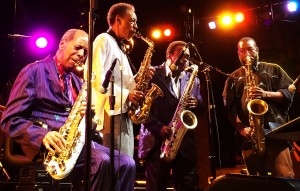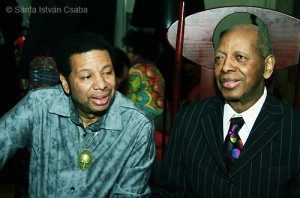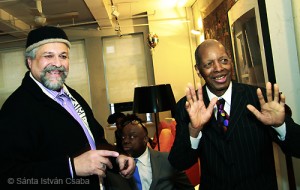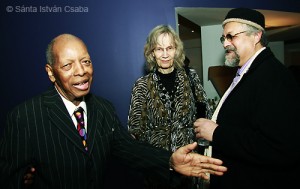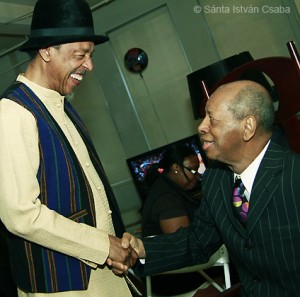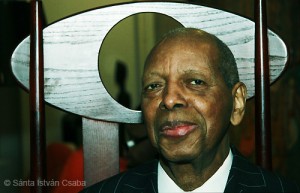
Ornette Coleman at his 84th birthday party.                 Photo by Sánta István Csaba
Sad news this morning: Ornette Coleman died at age 85. Triumphant news: Ornette Coleman returned music to its free-from-cant basics, emphasizing emotional communication and intuitive human interactions over any other elements in the dynamic, multi-faceted, immediate art form.
I included several interviews with Ornette — whom I consider the most fascinating and broadly insightful man I’ve met — in my book Miles Ornette Cecil — Jazz Beyond Jazz. I’ve written about Ornette several times on this blog. My obituary commissioned by National Public Radio can be heard here. Below is my review of what may have been Ornette’s final public performance in NYC, in June 2014 — published by The Wire.
Ornette Coleman (left) in Prospect Park with Henry Threadgill, David Murray and Antoine Roney; Â Â Â Â Â Â Â Â Â Â photo by Emilie Pons
Ornette Coleman is contemporary music’s great and radical idealist, for a half-century demonstrating how the whole world might harmonize by people expressing their innate individuality, even as he hews to his roots in the cry of the blues. On a muggy mid-week night at Brooklyn’s Prospect Park bandshell, the elite of hardcore saxophonists plus performers straddling art, pop, high tech and humankind’s primal roar convened in a concert called Celebrate Ornette!, attesting to the breadth, depth, efficacy and appeal of a concept that over the last half-century Ornette has called free jazz, harmolodics and sound grammar, yet seems simply a natural, intuitive way of playing.
Organized by Denardo Coleman, Ornette’s son, drummer and keeper of the flame, the show proved historic from its start, as 83-year-old Sonny Rollins, white-haired and stooped but verbally vigorous and emphatic, hobbled onstage to hail 84-year-old Ornette as a globally important musician and humanitarian, citing his credo “It’s all good!” Here was the living icon of jazz’s continuous lineage – the man who recorded with Coleman Hawkins as well as Miles Davis, Charlie Parker, Thelonious Monk and John Coltrane – proclaiming the supremacy of jazz’s ultimate iconoclast, the outsider who broke all rules while retaining the style’s essence. It was as dramatic a moment for devotees (count me among them) as when Ornette jammed with Sonny at the latter’s birthday show four years ago, the last time Rollins, now beset with respiratory problems, played publicly in New York City.
Walking with help from his grandson, Ornette edged out from the wings, humbled by the crowd’s roar, wiping his bright eyes. After receiving a rousing official commendation from the Brooklyn borough president, Ornette spoke: “Life is all we have,” he said, “so why don’t we all get together to help each other and make things happy? It’ll turn out like you will never forget it.” He took a seat. The music began.
Denardo’s Vibe, a newly established band of guitarist Charlie Ellerbee and electric piccolo bassist Albert McDowell (both from Ornette’s ’80s ensemble Prime Time), Ornette’s most recent upright bassist Tony Falanga and tenor saxophonist Antoine Roney, was to serve as foundation for an unprecedented parade of guests refreshing Ornette’s indelible if infinitely adaptable compositions, starting with “Rambling,” “The Turnaround” and “Blues Connotation.” First up was Red Hot Chili Peppers’ hyper-active electric bassist Flea and alto saxophonist Henry Threadgill, placing harsh notes so they’d stand out from the bottom-heavy din.
When tenor saxophonist David Murray joined them, Ornette called for his white alto sax, and soon Murray, Threadgill and Roney were blending on a riff through which Ornette’s wail rose, rough but commanding. Stage right, Savion Glover came on to tap dance, exuberantly physical and pouring sweat. Threadgill left, but pianist Geri Allen appeared, with trumpeter Wallace Roney Jr., her son, launching long, clear lines. Ornette beamed beatifically.
Joe Lovano with Ornette (Stanley Crouch seated between them) at 2014 birthday party; photo by Sánta István Csaba
Soon saxophonist Joe Lovano was onstage with them. He and Murray, Ravi Coltrane, Branford Marsalis (at one point in playful duet with pianist Bruce Hornsby) as well as Antoine Roney continued to blow various combinations at intervals throughout the evening, each saxophonist accepting the responsibility Ornette modeled to listen fully to the others as they used their virtuosic though idiosyncratic techniques to forge something new. Coltrane was particularly inspired on sopranino during one episode, in another Murray squealed roller-coaster phrases over Lovano’s fierce pumping of a motif of Coleman’s classic “Lonely Woman.” Throughout it all, Denardo driving Vibe set tempo, density and energy level changes.
Ornette at his 84th birthday party with Joanne Brackeen and Joe Lovano. Photo by Sánta István CsabaThroughout it all, Denardo driving Vibe set tempo, density and energy level changes.
Not only saxophonists or jazzers provided highlights. Patti Smith, her own band rustling behind her, recited a surreally imagistic poem that linked Ornette the child (and his parents) to Ornette the man. Guitarists Nels Cline of Wilco and Thurston Moore of Sonic Youth improvised a duet based on contrasting timbres [Cline later told me this was a version of a Coleman composition]. Laurie Anderson performed on electric violin against feedback loops her late husband Lou Reed had created for Metal Machine Music, with John Zorn chirping frantically on alto sax and Bill Laswell trolling the lowest range of electric bass. James Blood Ulmer, the first guitarist with whom Ornette recorded, sat in on “Theme from a Symphony” (aka “Dancing in Your Head”) with Marsalis, Laswell and Antoine Roney, and remained when two of the Master Musicians of Jajouka arrived to increase the overtone
quotient using double-reed raitas on Ornette’s explosive “Song X,” the finale in which everyone (except Threadgill, Smith and her group, Anderson, Zorn, Cline and Moore) raised an orchestral storm.
During the three-hour event, the audience of approximately 4000 ignored the threat of rain and an eventual misty drizzle. The crowd was all ages, races and genders, peppered with notable musicians, producers, critics and fans. The congregation had been called and eagerly convened, to celebrate, yes, but not worship Ornette – rather to bathe in the variety and joy of unfettered interaction he’s encouraged. His message: Spontaneous collective improvisation is the key human activity – past, present and future – productive and enriching as we listen closely, trying to help to each other. Amen.
Subscribe by Email |
Subscribe by RSS |
Follow on Twitter
[contextly_auto_sidebar id=”zZa458M7ck5ARtaFrYOP9V3LEeO0vZ6A”]

